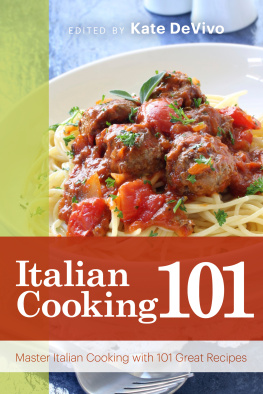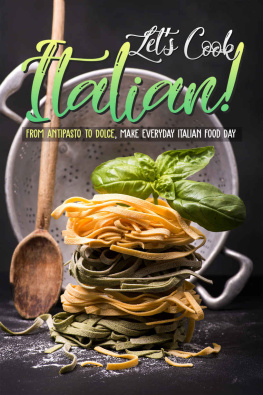
The Seasons of the Italian Kitchen
A L S O B Y D I A N E D A R R O W A N D T O M M A R E S C A
La Tavola Italiana
A L S O B Y T O M M A R E S C A
The Right Wine
Mastering Wine


| ATLANTIC MONTHLY PRESS |  |
| NEW YORK |
THE S EASONS
OF THE |  |
I TALIAN |
K ITCHEN
Diane Darrow and Tom Maresca
Some of the prose and recipes in this book have appeared, in slightly different forms, in other publications: Attenzione, Bon Apptit, Diversion, Food & Wine, New York Daily News, and Wine & Spirit.
Copyright 1994 by Diane Darrow and Tom Maresca
All rights reserved. No part of this book may be reproduced, stored in a retrieval system, or transmitted in any form, by any means, including mechanical, electronic, photocopying, recording, or otherwise, without prior written permission of the publisher.
Atlantic Monthly Press
841 Broadway
New York, NY 10003
Manufactured in the United States of America
Published simultaneously in Canada
Library of Congress Cataloging-in-Publication Data
Darrow, Diane.
The seasons of the Italian kitchen / Diane Darrow and Tom Maresca.1st ed.
Includes index.
ISBN 9780802193414
1. Cookery, Italian. 2. Seasons. I. Maresca, Tom. II. Title.
TX723.D286 1994 641.5945dc20 93-46761
Designed by Liney Li
First Paperback Edition
1 3 5 7 9 10 8 6 4 2
F O R
M A R Y D A R R O W
R O G E R D A R R O W
A N D
C O N S T A N C E M A R E S C A
ACKNOWLEDGEMENTS

This cookbook and the lore we've distilled into it are the result of years of reading, writing, and conversation with cooks and eaters and winemakers beyond counting, in Italy and in America. We owe debts to nameless waiters in little trattorias who told us, from years of seeing it done, exactly what the cook put into the sauce; to modest housewives and their mothers and their aunts and the cousins of their aunts, who told us how their ancestresses (and occasionally ancestors), who were the real cooks, handled the pasta or seasoned the veal. We've profited from every writer who came before us, from Platina and Pietro de Crescenzi and Vincenzo Corrado down to Anna Gosetti della Salda and Ada Boni and Vincenzo Buonassisi. Such debts can never be tallied and never repaid: they can only be acknowledged, and we gratefully do so here.
Among our friends and colleagues, some names call for specific mention for their long-term support and unfailing cooperation. We especially want to thank: Walt Bode and Felicia Eth, for the enthusiasm and expertise that they gave unstintingly to this book; Frank de Falco, for the warmth of his encouragement and the pertinence of his advice; Doreen Schmid, whilom American representative of the Chianti Classico Consortium, for unfailing faith in us and unending aid in prosecuting our plans; Tom Verdillo, resident genius of Tommaso's restaurant in Brooklyn, for his bottomless and freely shared treasury of Italian culinary lore; and, finally, the staff of the Italian Trade Commission, from receptionists to Dr. Giorgio Lulli, for cooperation and help that never slackened. Without all these unindicted co-conspirators, this book might never have been begun. Without them, it surely would never have been finished. Grazie a tutti.
Contents

The Seasons of the Italian Kitchen
Introduction: In Season

All things have their season: and in their times all things pass under heaven. A time to be born, and a time to die. A time to plant, and a time to pluck that which is planted.... And I have known that there was no better thing than to rejoice and to do well in this life. For every man that eateth and drinketh, and seeth good of his labor, that is the gift of God.
E CCLESIASTES 3
Anyone who has traveled in Italy and seen Italians at table notices the gusto with which they approach food and the endlessly renewed pleasure they take in it. Food in Italy is an occasion, a subject, an experience, a theme, an artifact, a celebration. You don't just eat in Italy: you look, you smell, you savor, you admire, you discuss, you deplore, you praise, you pass plates, you taste one another's dishes, you compare how they make the lasagna here with how your mother made it, or how the restaurant around the corner makes it, you argue, you order another dish, you cross-examine the waiter, you make him show you another fish or suggest a better wine, you all talk at once, you call for more bread, or more lemons, or extra-virgin olive oil, you prolong the dinner far beyond the ever-so-rational length of time Americans allot for fueling their systems, and because everybody is having such a good time, on the spur of the moment you order a bottle of Asti Spumante to finish up with, and you and everyone with you loves every nutritionally and dietetically excessive moment of it. Tomorrow you will probably make a magro dinner of frittata and green salad, but tonight you are seeing the good of your labor.
The rhythm and the spirit of Italian life grow out of a long-ingrained, deep-in-the-soul awareness of the truth of Ecclesiastes ancient wisdom, whose simplicity and starkness much of twentieth-century activity, at least in this country, seems bent on evading. Americans pursue one health chimera after another, apparently persuading themselves that if they eat enough fiber and jog enough miles they will live forever, or if they forego butter and wine and the pleasures of the table in the days of their youth, they will prolong their tedious, toothless old age of flavorless food and perpetual boredom into an eternity of the same.
Even the current fad for the Mediterranean diet gets it all wrong: it's not just what you eat, but how you eat, how you live. It isn't simply a balance of fresh fruits and vegetables, lots of fish and little meat, that keeps Mediterranean peoples safe from heart attacks and strokes: worrying about such balances is in fact just another mistake, another element of stress in American life, one more thing to make your life a constant misery instead of a steady pleasure. What makes the Mediterranean diet work is pleasure: stepping out of the rat race long enough to realize that the delicacy of this troutthe cool, acid tang of this glass of Verdicchiothe gush of sweet nectar from this huge, golden pearis exactly what you've been working for, that putting this simple, straightforward goodness on the table to share with your family and friends is the fruit of your labor, and it is worth it.
THE SEASONS
Seasonality is the heart and soul of Italian cooking. Whatever the region, local cooks throughout the peninsula depend on the simplestand for Americans the hardest to guaranteefactor of all for the success of their dishes: fresh ingredients bursting with flavor. No agribusiness tomatoes in the middle of winter or mushy McIntoshes in July, but cherries and strawberries in the spring, and wild mushrooms and wild game in the fall, and all things between in their own time. Each season brings its impatiently anticipated pleasures, the sharp, clear flavors that are all the better for being rare: the year's first tiny peas or its first glistening purple eggplants, spring's baby lambs or the hearty, warming polentas of winter. We know a little of that in this country, mostly in summer, and mostly from our own gardens or nearby farm stands. Remember how your mouth waters for the first real tomato of summer, still smelling of the vine, its scarlet skin glowing like a tiny sun. Remember how you anticipate the first, fresh-picked corn of the summer, the plump, moist kernels marshaled in their perfect platoons, each bursting with sweetness and just begging for its supererogatory slatherings of butter and salt. Those kinds of pleasuresthe sharpness of anticipation, the keen, clean, distinct taste of a vegetable or fish or fruit or flesh that is absolutely and perfectly itselfthose are what seasonality in the kitchen is all about.
Next page


















